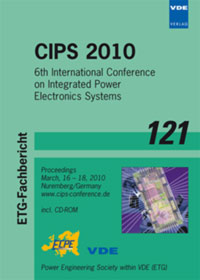Insulating IGBT Driver with PCB integrated capacitive coupling elements
Konferenz: CIPS 2010 - 6th International Conference on Integrated Power Electronics Systems
16.03.2010 - 18.03.2010 in Nuremberg, Germany
Tagungsband: CIPS 2010
Seiten: 6Sprache: EnglischTyp: PDF
Persönliche VDE-Mitglieder erhalten auf diesen Artikel 10% Rabatt
Autoren:
Zeltner, Stefan (Fraunhofer IISB, Erlangen, Germany)
Inhalt:
In many power electronic applications galvanic isolating IGBT/MOSFET drivers are advantageously used. The main reasons are safety issues, driving high voltage power semiconductors with blocking voltages of typically 600 V or above and avoiding or minimizing unwanted ground current loops. This paper deals with a new method for achieving galvanic isolation in high voltage drivers based on printed circuit board (PCB) integrated capacitive coupling elements. The suggested coupling element consists of a pair of plate capacitors by using copper layers and prepregs of a PCB. First, the influence of the isolation barrier capacitance, which is one of the main important parameters of a galvanic insulating driver, is illustrated by a simple model of the capacitive current loop. As a result it is stated that the coupling capacitance should be lower than 5 pF to achieve high dV/dt levels of at least 100 kV/mus. Taking into account the isolation characteristics of the commonly used FR4 PCB material, an integrated capacitive coupling element can be designed. With 360 µm isolation distance and a plate surface of approximately 8 mm2, a capacitance of about 1 pF is achieved. A comparison of the developed capacitive coupling element with a comparable inductive coupling element (transformer) shows that the former has advantages due to a much lower current consumption and less dependency on parasitic inductances. In order to achieve high isolation voltages on PCBs, wide creepage and clearance distances are required, especially at higher humidity levels. It is advisable to use special layout were the primary and the secondary circuits of the driver are placed on different sides on the PCB by using blind vias. The well known Manchester coding can be applied to use the advantages of phase modulated signals for transmitting the switching signal over the isolation barrier. By transmitting the carrier signal via a second capacitive coupling element, the complexity for decoding the switching signal is reduced. A half bridge driver was built up to verify the new isolation method. Herewith a bidirectional buck-boost DC/DC converter operating at a DC link voltage of 400 V was successfully controlled. Moreover, measurements with a standardized burst generator have shown, that a fail-safe operation is possible up to high dV/dt levels.


